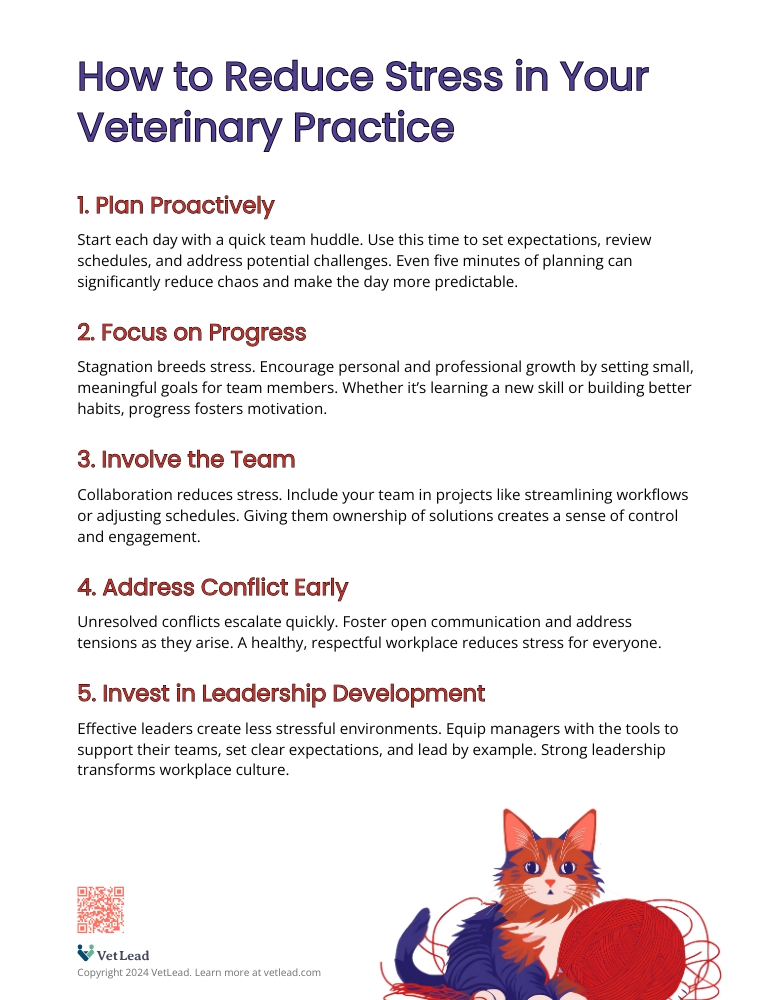Stress isn’t just part of the job in veterinary medicine—it’s a reality many practices face daily. Long hours, unpredictable schedules, and the emotional weight of caring for pets and clients can make stress feel unavoidable. But here’s the good news: stress doesn’t have to define your practice. With the right strategies, you can create an environment where your team feels supported, engaged, and ready to thrive—even on the busiest days.
Let’s explore what causes stress, how to reduce it effectively, and what doesn’t work. Along the way, you’ll find practical steps to help your team navigate challenges with confidence and resilience.
What Causes Stress in Veterinary Clinics
Stress often stems from the unexpected—the moments when reality doesn’t align with expectations. While heavy workloads contribute, stress goes deeper than just “too much to do.” Here are some common triggers in veterinary practices:

- Unpredictability: Chaos is part of the job, but it’s harder to manage when we’re caught off guard. Sudden changes, like no-shows or emergency cases, can create stress by disrupting expectations.
- Lack of Control: Feeling powerless—whether it’s over schedules, processes, or decisions—makes the workplace more stressful. Giving your team a sense of autonomy can help ease this pressure.
- Interpersonal Conflict: No one thrives in a toxic environment. Even minor tensions can escalate when left unresolved, amplifying stress for the entire team.
- Inefficiencies: Waiting on test results, juggling unclear priorities, or repeating unnecessary steps wastes time and creates frustration. Streamlined processes can make a world of difference.
- A “Stuck” Mentality: If nothing seems to improve, stress builds. Whether it’s a lack of growth opportunities or persistent challenges, feeling stuck adds to the pressure.
How to Reduce Stress in Your Veterinary Practice
The Veterinary Leadership Program
Kicking off January 2025
Get info on this exclusive program.
Learn how to:
- 1Build an accountable team
- 2Make change happen
- 3Improve performance
- 4Hire exceptional talent
Includes live coaching.
Investment will be $897 per person
Reducing stress takes more than temporary fixes. It requires thoughtful leadership and strategies that address the root causes. Here’s what works:
1. Plan Proactively
A little planning goes a long way. Start the day with a brief huddle to set expectations, review schedules, and address potential challenges. This doesn’t have to take long—even five minutes can help align the team and reduce chaos. When the day feels more predictable, stress levels drop.
2. Focus on Progress
Stress thrives in stagnation. To counter it, focus on small, meaningful progress. Encourage team members to set personal goals or learn new skills. When people feel like they’re growing, they’re less likely to feel overwhelmed by the day-to-day grind.
3. Involve the Team
Collaboration isn’t just good for morale—it’s a stress reliever. Invite your team to participate in projects that improve workflows or address inefficiencies. For example, reimagining how client histories are collected or adjusting the scheduling process can give your team a sense of ownership and control.
4. Address Conflict Early
Interpersonal issues don’t go away on their own. In fact, unresolved conflicts tend to grow, creating even more stress. Encourage open communication and tackle issues as they arise. It’s much easier to address small tensions than to deal with the fallout of ongoing resentment.
5. Invest in Leadership Development
Great leaders reduce stress by providing stability, clarity, and support. Train your managers to coach their teams effectively, set realistic expectations, and lead by example. When leadership is strong, stress decreases—and the team thrives.
What Doesn't Reduce Stress

Some well-intentioned solutions fail to reduce stress long-term. Avoid these common pitfalls:
1. Breaks Without Solutions
Longer lunches or extra breaks might sound helpful, but they only provide temporary relief. If the underlying issues remain unresolved, the stress comes right back.
2. Cutting the Workload Alone
Reducing appointments or scaling back hours might ease the immediate pressure, but it’s not sustainable. True stress reduction comes from improving efficiency and teamwork—not just doing less.
3. Keeping or Hiring the Wrong People
A poor hire can add more stress than being short-staffed. Similarly, holding on to underperforming team members because “we need the help” only hurts morale and productivity.
4. Micromanagement
Hovering over your team or focusing on what’s wrong creates more stress, not less. Trust your team to make decisions and provide them with the tools they need to succeed.
Creating a Stress-Resilient Veterinary Practice

Download this accompanying PDF Now
Share it with leaders and teams. No email address required.
Stress doesn’t have to feel like a permanent fixture in veterinary medicine. By understanding its root causes and implementing strategies that truly work, you can create a practice where your team feels empowered, supported, and engaged.
Start with small changes: plan your day, involve your team, and invest in leadership development. Over time, these efforts add up, creating a practice culture that’s not only less stressful but also more resilient and rewarding.
The road to reducing stress is a journey, but it’s one worth taking—for your team, your clients, and yourself.
Take the Next Step Toward a Thriving Practice
Ready to create lasting positive change in your practice? The Veterinary Leadership Program provides six flexible, strategic modules that equip you with personalized tools and techniques to reduce stress, enhance teamwork, and lead with confidence—all without sacrificing your time.
Join the hundreds of veterinary leaders who’ve transformed their practices. Learn more about the Veterinary Leadership Program or reach out today to get started.
